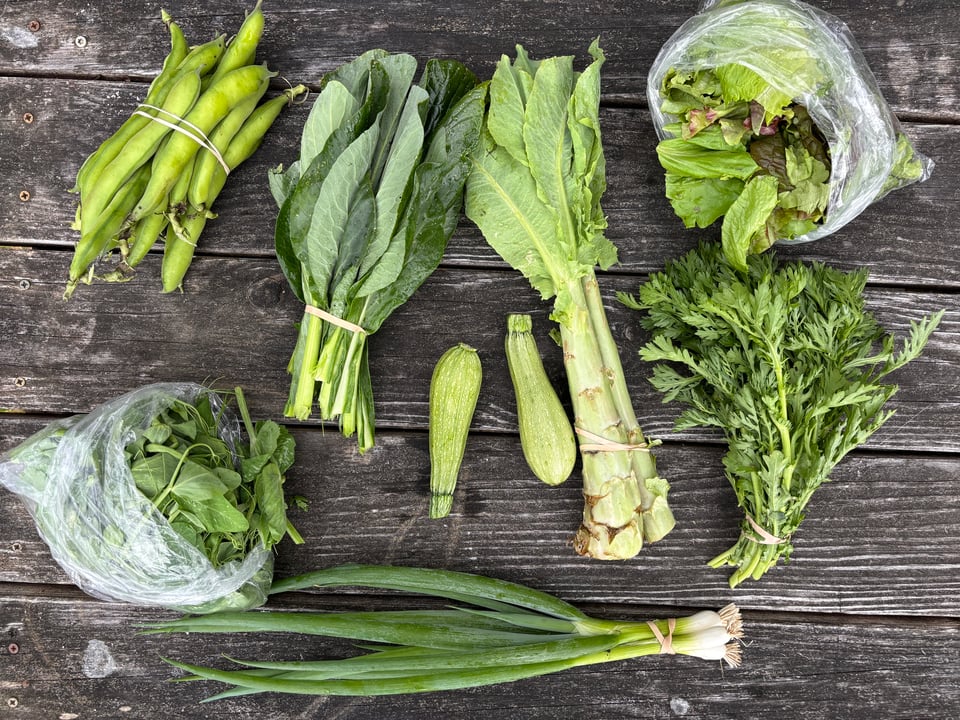CSA Week 5: Fava beans and summer squash!

Tian Tian Farm Newsletter - June 26, 2024

Logistics
Reminder! There won't be any deliveries next week, on either Wednesday (7/4) or Thursday (7/5). We'll be traveling out of the country with limited internet access, so email responses might take a longer too. Deliveries will resume the following week.
Also! Please remember to bring broken-down boxes back to your delivery spot when you pick up your share. We re-use boxes to keep our costs down.
This Week's Share (From L to R, top to bottom):
Fava beans
Komatsuna
Celtuce
Salad mix
Pea vines
Summer squash (yellow or romanesco)
Chrysanthemum greens
Scallions
It’s our first fava beans harvest of the season! This time, you’ll get a pound. We hope to give you much more the second go around. Check the bottom of this email for a hassle-free recipe.
I believe this is our first showing of komatsuna in this season’s CSA, which is surprising because it is a staple at Tian Tian Farm. It’s a hearty, sturdy mustard green good for stir fries, soups, blanched preparations, you name it.
Our celtuce has begun to bolt, so we recommend a stir-fry preparation for this week’s offering.
Much of our lettuce goes to a salad mix that we sell at market. We harvested a lot this week because we’ll be gone next week. It’s pre-washed and spun, and ready for your dressing.
This might be the last bag of pea vines for a while this season. We might have some more in the fall.
Expect to see lots of summer squash in the coming weeks.
Our chrysanthemum greens are also beginning to flower, at which point they take on a stronger flavor. Cook them to neutralize a bit.
And more scallions!
Rocks
More than ten thousand years ago, the Cordilleran Ice Sheet slowly drifted southward, forming much of the Pacific Northwest, and bringing to this region countless rocks. Over eons, organic matter and sediments slowly buried those rocks. (If there are any geologists reading this… sorry.)
In 2021, we paid our neighbor to plow about 2/3 acres of pasture. His tractor broke through clods of crabgrass and formed the foundation of Tian Tian Farm. It also unearthed many rocks. So many rocks.
We spent much of 2021 picking up rocks. Big rocks, small rocks. Rocks the size of every sports ball. Armful-sized boulders requiring shoveling and risking back injury. Pebbles across the earth-tone gradient, sharp, round, and in between.
Most of those rocks ended up in growing rock piles. Some of them filled empty feed bags, creating weights to hold down tarps, row cover, and landscape fabric. Many others were surreptitiously launched over the deer fence, into the woods separating our landlady and our landlady’s neighbor.
Every season since 2021, we’ve continued to pick up rocks. Our goal is to keep walkways free of trip hazards, our planting beds free of obstructions. We will never reach rock-free utopia, and we’ve learned to make peace with that. Rocks often come in handy, as makeshift mallets for pounding in stakes, as table stabilizers, or as markers for delineating exactly where we ran out of carrot seeds.
The vast majority of the rocks, however, are a nuisance. Sometime in March or April, during the spring haze, I knelt on a pebble. The contact sent a jolt of pain to my knee, and that knee has been sensitive ever since. Ever since, I’ve been even more fastidious about picking up rocks.
Recipe: Lazy Fava Beans

From a strictly business perspective, it’s hard to make the case for growing fava beans. They take up a lot of space in the field, for little return. We like planting them anyway, because they’re the first crop that goes in the ground (in February) and for their nitrogen-fixing quality.
Fava beans offer similarly low returns in the kitchen, at least on an prep-effort-to-food-quantity basis. The typical preparation involves shelling the beans from their pod, and then removing each bean’s waxy coating before blanching them. If you have the time, it’s worth the effort, and here’s a recipe for that. If you don’t have the time, you can prep them like we did last night, as an edamame-like table snack.
Ingredients:
Fava beans, whole, unshucked
Olive oil
Salt and pepper, to taste
Directions:
In a large bowl toss fava beans with olive oil, salt, and pepper.
Place fava beans in a single layer on a baking sheet.
Broil on low until fava bean pods are soft, about 5 to 7 minutes.
Set broiler to high for a minute or two to brown pods.
Cool for a minute or two before serving.
Eat like edamame. Beans should easily pop out of their shells, as well as their waxy coating. I don’t mind the coating. Elizabeth prefers no coating.
‘Til next time,
Steven
